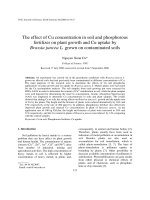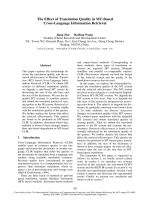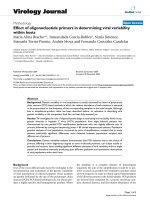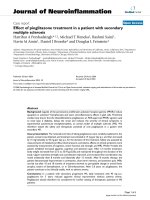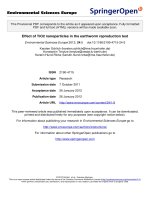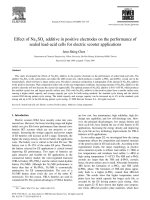Effect of invitro rooting in coccinia grandis (L.) through nodal segments
Bạn đang xem bản rút gọn của tài liệu. Xem và tải ngay bản đầy đủ của tài liệu tại đây (362.83 KB, 7 trang )
Int.J.Curr.Microbiol.App.Sci (2020) 9(7): 2266-2272
International Journal of Current Microbiology and Applied Sciences
ISSN: 2319-7706 Volume 9 Number 7 (2020)
Journal homepage:
Original Research Article
/>
Effect of invitro Rooting in Coccinia grandis (L.) through Nodal Segments
Mohammad Amin1*, A. V. D. Dorajee Rao2, K. Ravindra Kumar2
and D. R. Salomi suneetha3
1
Department of Vegetable Science, 2Department of Horticulture, 3Department of
Biochemistry, College of Horticulture, Dr.Y.S.R Horticultural University,
Venkataramannagudem, West Godavari, India
*Corresponding author
ABSTRACT
Keywords
In vitro rooting,
coccinia, Nodal
segments
Article Info
Accepted:
20 June 2020
Available Online:
10 July 2020
An experiment was conducted on in vitro rooting in Coccinia grandis (L.) through nodal
segments with an objective to standardise a viable protocol for in vitro propagation.
Maximum number of shoots producing roots was noticed in ½ MS + 0.5 mg l -1 IBA which
was on par with ½ MS + 1.0 mg l-1 IBA and ½ MS + 0.5 mg l-1 NAA. The maximum
number of roots per shoot (6.00) was observed by ½ MS + 1.0 mg l -1 IBA (T2) and ½ MS
medium devoid of any growth regulators as control. The maximum girth of longest root
was recorded by ½ MS + 0.5 mg l-1 IBA which was on par with ½ MS + 0.5 mg l-1 NAA
but significantly superior to the MS + 1.0 mg l -1 NAA. The root colour was observed as
white in ½ MS + 0.5 mg l-1 IBA (T1), ½ MS + 1.0 mg l-1 IBA (T2) and ½ MS medium
devoid of any growth regulators as control whereas pale white colour root was observed in
the rest of treatments.
Introduction
Coccinia grandis L. belongs to the family
Cucurbitaceae and is described as ‘Indian
substitute for Insulin”. It grows widely
throughout India and other tropical countries
but it is commonly found in the southern
Indian states, where it forms a part of the
local cuisine. Ivy gourd has been extensively
used in ayurvedic and unani practices in the
Indian Subcontinent. It contains several
phytoconstituents such as cephalandrol,
iritriacontane, Triterpenoids, alkaloids and
tannins.
The
plant
also
possesses
hypoglycemic effects and acts as insulin
mimetic (Thiripurasundari and Rao, 2012).
General barriers like poor seed setting and
low seed germination is a common in
Cucurbits including Coccinea, probably due
to the presence of a thin nucellar membrane
lending impermeability to water and gases
making them dormant for many days
(Thiripurasundari and Rao, 2012). The use of
tissue culture techniques for clonal
propagation has become the most widely used
application of tissue culture technology in
horticultural crops in the recent years
(Thorpe, 1990). In vitro propagation can
effectively escape from these problems and as
such micro propagated material are reported
to grow faster and mature earlier than seed
propagated ones (Vasil and Vasil, 1980). The
2266
Int.J.Curr.Microbiol.App.Sci (2020) 9(7): 2266-2272
present investigation is undertaken with a
view to standardise the techniques of surface
sterilisation, aimed at developing a viable
protocol for propagation of coccinea through
in vitro procedures.
Materials and Methods
An investigation was carried out at Tissue
Culture Laboratory, Horticultural Research
station, Kovvur, College of Horticulture, Dr.
Y.
S.
R.
Horticultural
University,
Venkataramannagudem, Andhra Pradesh,
during the year 2019-2020.
Number of shoots producing roots
The treatments varied significantly in terms of
number of shoots producing roots. The mean
number of shoots producing roots was 7.61
(Table 3.1). The maximum number of shoots
producing roots was noticed in ½ MS + 0.5
mg l-1 IBA (T1) (9.50) which was on par with
½ MS + 1.0 mg l-1 IBA (T2) (8.75) and ½ MS
+ 0.5 mg l-1 NAA (T3) (8.25) but significantly
superior to the ½ MS + 0.5 mg l-1 NAA + 0.5
mg l-1 IBA (T5). However, the minimum
number of shoots producing roots was (6.25)
observed in ½ MS + 1.0 mg l-1 NAA + 1.0 mg
l-1 IBA (T6).
Plant material
Rooting percentage (%)
Nodal segments of ivy gourd were involved in
the present study. Nodal segments (two cm
long) were collected from young vines
maintained in the propagation chamber at the
HRS, Kovvur and were used for the
preparation of explants.
To find out the best in vitro rooting media, the
nodal segments were pre-treated with the best
treatment of Carbandazim (0.2%) +
Mancozeb & Metalaxyl (0.2%) + 200 ppm 8
HQ for 60 min, then explants sterilized with
best treatment of 0.1% HgCl2 for 4 minutes
and the better culture establishment was
effectively induced by TDZ at 0.5 mg l-1
concentration for shoot induction and
succeeding growth in the present study.
Results and Discussion
In vitro rooting
The third experiment was conducted on
standardisation of different growth regulator
concentrations for in vitro rooting. The results
for number of shoots producing roots, rooting
percent, number of roots per shoot and length
of longest root after 20 days of culture are
described hereunder
The rooting percentage exhibited significant
differences among the treatments (Table 3.1).
The mean rooting per cent was (76.07%). The
highest rooting per cent was recorded in ½
MS + 0.5 mg l-1 IBA (T1) (95.00%) which
was on par with ½ MS + 1.0 mg l-1 IBA (T2)
(87.50%) but significantly superior to the ½
MS + 0.5 mg l-1 NAA (T3) (82.50%).
However, the least rooting per cent (62.50%)
was noticed by in ½ MS + 1.0 mg l-1 NAA +
1.0 mg l-1 IBA (T6) which was on par with ½
MS medium devoid of any growth regulators
as control (T7) (67.50%) and ½ MS + 1.0 mg
l-1 NAA (T4) (65.00%).
Number of days taken for rooting
The treatments varied significantly in terms of
number of days taken for rooting. The mean
number of days taken for rooting was (8.29)
(Table 3.1). The minimum number of days
taken for rooting was noticed in ½ MS + 0.5
mg l-1 IBA (T1) (6.20) which was on par with
½ MS + 1.0 mg l-1 IBA (T2) (6.60) and ½ MS
+ 0.5 mg l-1 NAA (T3) (8.25) but significantly
superior to the ½ MS + 1.0 mg l-1 NAA (T4).
However, the maximum number of days taken
for rooting was (11.50) observed in ½ MS
2267
Int.J.Curr.Microbiol.App.Sci (2020) 9(7): 2266-2272
medium devoid of any growth regulators as
control (T7) (11.50).
Number of roots per shoot
The differences were found to be significant
among the treatments with respect to number
of roots per shoot. The mean number of roots
per shoot was (4.14) (Table 3.2). The
maximum number of roots per shoot (6.00)
was observed by ½ MS + 1.0 mg l-1 IBA (T2)
and ½ MS medium devoid of any growth
regulators as control (T7).
Table.1 Effect of different auxins on rooting and days taken for rooting during in vitro root
induction of coccinea nodal segments
Treatments
T1 : ½ MS + 0.5 mg l-1 IBA
No. of shoots
cultured
10
No. of shoots
producing roots
9.50
T2 : ½ MS + 1.0 mg l-1 IBA
10
8.75
T3 : ½ MS + 0.5 mg l-1 NAA
10
8.25
T4 : ½ MS + 1.0 mg l-1 NAA
10
6.50
T5 : ½ MS + 0.5 mg l-1 NAA + 0.5 mg/l IBA
10
7.25
T6 : ½ MS + 1.0 mg l-1 NAA + 1.0 mg l-1 IBA
10
6.25
T7 : ½ MS medium devoid of any growth
regulators as control
Mean
10
6.75
10.00
7.61
Rooting
(%)
95.00
(77.05)
87.50
(69.27)
82.50
(65.24)
65.00
(53.71)
72.50
(58.35)
62.50
(52.22)
67.50
(55.22)
76.07
(61.58)
1.85
7.87
5.65
0.35
1.51
1.08
S Em
CD at 0.01
CD at 0.05
No. of days taken
for rooting
6.2
6.6
7.5
8.4
8.8
9.0
11.5
8.29
0.36
1.51
1.09
Table.2 Effect of different auxins on root parameters during in vitro root induction of coccinea
nodal segments
Treatments
T1 : ½ MS + 0.5 mg l-1 IBA
T2 : ½ MS + 1.0 mg l-1 IBA
T3 : ½ MS + 0.5 mg l-1 NAA
T4 : ½ MS + 1.0 mg l-1 NAA
T5 : ½ MS + 0.5 mg l-1 NAA + 0.5 mg l-1 IBA
T6 : ½ MS + 1.0 mg l-1 NAA + 1.0 mg l-1 IBA
T7 : ½ MS medium devoid of any growth regulators as
control
Mean
S Em
CD at 0.01
CD at 0.05
2268
No. of
roots per
shoot
5.00
6.00
3.00
4.00
2.00
3.00
6.00
Length of the
longest root
(cm)
4.20
4.80
3.80
3.20
3.00
2.80
5.30
Girth of the
longest root
(mm)
0.98
0.87
0.92
0.89
0.78
0.76
0.36
4.14
0.31
1.34
0.96
3.87
0.19
0.81
0.58
0.79
0.04
0.18
0.13
Root
colour
white
white
white
Pale white
Pale white
Pale white
white
Int.J.Curr.Microbiol.App.Sci (2020) 9(7): 2266-2272
Fig.1 In vitro rooting of coccinea nodal segments in vitro as influenced by different growth
regulator concentrations
T1:
T2:
T3:
T4:
T5:
T6
T7
½
½
½
½
½
½
½
Treatments
MS + 0.5 mg l-1 BAP
MS + 1.0 mg l-1 BAP
MS + 0.5 mg l-1 NAA
MS + 1.0 mg l-1 NAA
MS + 0.5 mg l-1 BAP + 1.0 mg l-1 NAA
MS + 1.0 mg l-1 BAP + 1.0 mg l-1 NAA
MS medium devoid of any growth regulators as control
2269
Int.J.Curr.Microbiol.App.Sci (2020) 9(7): 2266-2272
Plate.1 Effect of different auxins on Coccinia micro-shoots in vitro rooting
0.5 IBA, 1.0 IBA, 0.5 NAA, 1.0 NAA and Control from left to right
0.5 IBA media (Best treatment)
1.0 NAA + 1.0 IBA media
1.0 NAA media
Control
2270
Int.J.Curr.Microbiol.App.Sci (2020) 9(7): 2266-2272
The minimum number of roots per shoot was
(2.00) recorded in ½ MS + 0.5 mg l-1 NAA +
0.5 mg l-1 IBA (T5).
Length of longest root (cm)
Significant differences were exhibited for
length of longest root among the treatments
(Table 3.2). The mean length of longest root
was (3.87 cm). The maximum length of
longest root was recorded by ½ MS medium
devoid of any growth regulators as control
(T7) (5.30 cm) which was on par with ½ MS +
1.0 mg l-1 IBA (T2) (4.80 cm) and ½ MS + 0.5
mg l-1 IBA (T1) (4.20 cm). However, The
minimum length of longest root was (2.80
cm) observed in ½ MS + 1.0 mg/l NAA + 1.0
mg l-1 IBA (T6).
Girth of the longest root (mm)
Significant differences were exhibited for
girth of the longest root among the treatments
(Table 3.2). The mean girth of the longest
root was (0.79 mm). The maximum girth of
longest root was recorded by ½ MS + 0.5 mg
l-1 IBA (T1) (0.98 mm) which was on par with
½ MS + 0.5 mg l-1 NAA (T3) but significantly
superior to the MS + 1.0 mg l-1 NAA (T4).
However, the minimum girth of longest root
was (0.36 mm) observed in ½ MS medium
devoid of any growth regulators as control
(T7).
Root colour
Significant differences were exhibited for root
colour among the treatments (Table 3.2). The
root colour was observed as white in ½ MS +
0.5 mg l-1 IBA (T1), ½ MS + 1.0 mg l-1 IBA
(T2) and ½ MS medium devoid of any growth
regulators as control (T7) whereas pale white
colour root was observed in ½ MS + 0.5 mg l-1
NAA (T3), MS + 1.0 mg l-1 NAA (T4), ½ MS +
0.5 mg l-1 NAA + 0.5 mg l-1 IBA (T6) and ½
MS + 1.0 mg/l NAA + 1.0 mg l-1 IBA (T6).
Induction of roots from callus is one of the
most critical steps for in vitro propagation of
plants. This brings qualification for in vitro
generated plantlets to get themselves eligible
for further life in normal growth media under
semi protected and open conditions. In the
present study, half MS media coupled with
0.5 mg l-1 IBA (T1), 1.0 mg l-1 IBA (T2) and
0.5 mg l-1 NAA (T3) were found to be
superior performers for the number of shoots
producing roots, rooting percentage, number
of roots and girth of roots. Healthy white
colour of roots was observed on the cultures
rooted from 0.5 mg l-1 IBA (T1), 1.0 mg l-1
IBA (T2) as compared to other growth
regulators.
In sweet potato, Parvin et al., (2018) the
maximum root initiation percentage (94.12),
the minimum days for root initiation (6.00),
the highest number of root/plantlet (9.33) and
the maximum root length (11.13 cm) was
found in the MS medium supplemented with
IBA 0.5 mg l-1 + NAA 0.1 mg l-1. This result
was also supported by findings of made by
Ashrafuzzaman et al., (2009).
The probable reason for the superior
treatments as above might be that IBA and /
or NAA at the above concentrations
accelerated more cell division and cell
elongation of root than other treatments thus
causing more number of roots per plantlet.
Some concentrations of IAA produced very
less number of roots as compared to IBA at
the same strength. The reduced rooting may
be due to the imbalance between the
endogeneous rooting auxin and exogeneous
auxins (Ghanthikumar et al., 2013 and Ani
Rani et al., 2019). Culture media
supplemented with IBA alone responded well
as compared to media fortified with other
synthetic auxins (NAA) even in higher
concentrations. Kurmi et al., (2011) suggested
that IBA promotes in vitro rooting of
shootlets. Auxins promoted adventitious root
2271
Int.J.Curr.Microbiol.App.Sci (2020) 9(7): 2266-2272
development on intact plants as well as
excised stems. Of these, IBA was the most
effective than any other synthetic auxins in
most of the cases, apparently because it is not
destroyed by IAA oxidase or other enzymes
and therefore persists longer. These facts are
confirmed by the results obtained from the
present study.
References
Ani Rani, B, J. Anbumalarmathi, J. and
Sharmili. S.A. 2019. In vitro propagation
of coccinia indica (L.) Voigt. From
intermodal segments. Indian Journal of
Agriculture Research. 53(2): 202-07.
Ashrafuzzaman, F, Hossain, M, Ismail, M.R,
Shahidul, M, Haque, M, Shahidullah, S. M.
and Shahin, U. Z. 2009. Regeneration
potential of seedling explants of Ipomoea
batatas L. Journal of Applied Horticulture
3:17–22.
Ghanthikumar, S, Arulanandam, L.J.P. and
Henry, J.L. 2013. Micropropagation of
Coccinia indica Wight & Arn.- A
medicinal plant. International Journal of
Applied Biology Research.18: 1-4.
Kurmi, U.S, Sharma, D.K, Tripathi, M.K,
Tiwari, R, Baghel, B.S. and Tiwari, S.
2011. Plant regeneration of Vitis vinifera
(L) via direct and indirect organogenesis
from cultured nodal segments. Journal of
Agricultural Technology. 7(3): 721-37.
Parvin, J, Robbani, M, Hasan, Md.F. and
Farhana, H. 2018. Standardization of plant
growth
regulators
for
successful
tissueculture of sweet potato. Journal of
Bangladesh Agricultural University. 16(2):
178-81.
How to cite this article:
Mohammad Amin, A .V. D. Dorajee Rao, K. Ravindra Kumar and Salomi suneetha, D. R.
2020. Effect of invitro Rooting in Coccinia grandis (L.) through Nodal Segments.
Int.J.Curr.Microbiol.App.Sci. 9(07): 2266-2272. doi: />
2272

